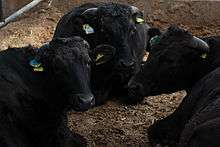Wagyu

Wagyu (和牛 Wagyū, "Japanese cow") is any of several breeds of cattle, the most desired of which is genetically predisposed to intense marbling and to producing a high percentage of oleaginous unsaturated fat. The meat from such wagyu cattle is known for its quality, and commands a high price. In several areas of Japan, wagyu beef is shipped carrying area names. Some examples are Matsusaka beef, Kobe beef, Yonezawa beef, Mishima beef,[1] Ōmi beef and Sanda beef.
History
Japan


Because of Japan's rugged terrain and isolated areas, different breeding and feeding techniques were used such as massaging or adding beer or sake to their feeding regimen. It is suggested that the feeding of beer and sake was done to aid in digestion and induce hunger during humid seasons, and that massaging prevented muscle cramping on small farms in Japan where the animals did not have sufficient room to use their muscles. Neither of these techniques affect the meat's flavor, and they have both been discontinued.[2][3]
There are four breeds of wagyu: Japanese Black (黒毛和種 Kuroge Washu), Japanese Brown (赤毛和種 Akage Washu or Akaushi), Japanese Polled (無角和種 Mukaku Washu), and Japanese Shorthorn (日本短角和種 Nihon Tankaku Washu).[4][5] Wagyu cattle's genetic predisposition yields a beef that contains a higher percentage of omega-3 and omega-6 fatty acids than typical beef. The increased marbling also increases the ratio of monounsaturated fats to saturated fats.[6]
Japanese Black makes up 90% of all fattened cattle in Japan.[7] Strains of Japanese Black include Tottori, Tajima, Shimane and Okayama.[8] Japanese Brown, also known as Japanese Red,[7] is the other main breed;[8] strains include Kochi and Kumamoto. Japanese Shorthorn makes up less than one percent of all cattle in Japan.[9]
Australia
The Australian Wagyu Association is the largest breed association outside Japan.[10] Both fullblood and Wagyu-cross cattle are farmed in Australia for domestic and overseas markets, including Taiwan, China, Hong Kong, Singapore, Indonesia, the U.K., France, Germany, Denmark and the U.S.[11] Australian Wagyu cattle are grain fed for the last 300–500 days of production. Wagyu bred in Western Australia's Margaret River region often have red wine added to their feed as well.[12]
United States
In the United States, Japanese Wagyu cattle are bred with Angus cattle. This crossbreed has been named American Style Kobe Beef.[13] Wagyu were first competitively exhibited at the National Western Stock Show in 2012.[14] Some U.S. Wagyu breeders have full blooded animals directly descended from original Japanese bloodlines, and are registered through the American Wagyu Association.[15]
Canada
Wagyu cattle farming in Canada appeared after 1991 when the Canadian Wagyu Association was formed. Wagyu style cattle and farms in Canada are found only in Alberta,[16] Ontario[17] and Prince Edward Island.[18] Canadian Wagyu beef products are exported to the U.S., Australia, New Zealand, Hawaii and Europe.[18]
Scotland
The firm Highland Wagyu was established in 2011[19] and is based at Blackford Farms in Dunblane, Scotland. The company acquired a herd of 300 Wagyu cattle to add to its existing herd of 250 in July 2013 and became the largest producer of Fullblood Wagyu beef in the UK with plans to make Scotland the Wagyu centre of Europe.[20][21][22]
References
- ↑ http://www.nodai-genome.org/bos_taurus.html?lang=en
- ↑ "Wagyu Beef History". Kobe-beef.com. 22 March 1998. Archived from the original on 2010-03-24. Retrieved 2009-05-10.
- ↑ Professor Kiyoshi Namikawa, Dept. of Animal Sciences, Kyoto University; Kyoto, Japan (1985). "Breeding History of Japanese Beef Cattle...". Archived from the original on 2012-04-15.
- ↑ Porter, Valerie; Mason, Ian Lauder (2002). Mason's world dictionary of livestock breeds, types, and varieties. CABI. p. 66. ISBN 0-85199-430-X.
- ↑ "What is Wagyu?". Japan Meat Information Service Center.
- ↑ Condon, John (March 2005). "Good Fats Boost Wagyu Opportunities". Australian Wagyu Update. Archived from the original on 29 August 2007. Retrieved 2006-12-07.
- 1 2 "Wagyu Japanese Beef" (PDF).
- 1 2 "Wagyu - What are they? Where did they come from?".
- ↑ "Japanese Shorthorn Cattle".
- ↑ "Australian Wagyu Forum".
- ↑ Exports; Australian Wagyu Association; accessed .
- ↑ http://www.mrpme.com.au/wine-fed-wagyu
- ↑ U.S. ranches breed famous Kobe-style beef; 12 August 2011 article in The Japan Times" (from the Associated Press); p. 3; accessed .
- ↑ Raabe, Steve (11 January 2012). "Tender Wagyu muscles onto meat scene, makes stock-show exhibition debut". The Denver Post.
- ↑ Membership | Calf Registration | DNA Tests
- ↑ Kobe beef on P.E.I.? Veterinarian raising wagyu cattle; The Chronicle Herald online; accessed .
- ↑ Kuntz First to Breed Wagyu in Ontario; The Post South Bruce; accessed .
- 1 2 About Us; Canadian Wagyu online; accessed.
- ↑ "Try a little tenderness: on the farm with Scotland's Wagyu cattle". The Herald. Retrieved 19 November 2012.
- ↑ "Scottish farm to make Japanese Wagyu beef". The Scotsman. Retrieved 29 July 2013.
- ↑ "Highland Wagyu beef firm in expansion drive". BBC News. Retrieved 29 July 2013.
- ↑ "Perthshire - the Wagyu centre of Europe". The Scottish Farmer. Retrieved 1 August 2013.
Further reading
- Hongo, Jun (6 July 2010). "Despite 'wagyu's' history, foot-and-mouth hit hard". The Japan Times. FYI (weekly column).
External links
| Wikimedia Commons has media related to Wagyū. |
- Wagyu Registry Association (Japanese)
- American Wagyu Association
- Australian Wagyu Association
- Canadian Wagyu Association
- European Wagyu Association
- German Wagyu Association
- Austrian Wagyu Association
- Wagyu Research and Information Department of Animal Sciences, Washington State University